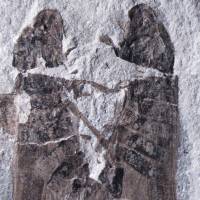Chinese researchers have found what they say is the oldest example of insects mating.
These ancient froghoppers, or adult spittlebugs, lived about 165 million years ago and died apparently doing what comes naturally.
Other fossils of insects copulating have been found; most of those 30-some examples are preserved in amber. The researchers from Beijing's Capital Normal University and other institutions write that this sparse fossil record makes it difficult to determine how and why insect copulation evolved.
The position of the two froghoppers and the shape of their genitalia suggest that froghoppers' mating habits haven't changed much since this pair lived. They, like their modern relatives, mated either while facing one another or while perched side by side.
The fossil clearly shows, the researchers said, that "the male's aedeagus (reproductive organ) is inserted inside the bursa copulatrix of the female."
The fossils appear to belong to a previously unknown species, which the authors named Anthoscytina perpetua. Anthoscytina is the name of the genus, while the species name perpetua, the researchers write, comes "from the Latin perpet, eternal love, in reference to this everlasting copulation."
The researchers' paper, in the online journal PLOS One, is titled "Forever Love: The Hitherto Earliest Record of Copulating Insects from the Middle Jurassic of China."
The fossils of the bugs in flagrante delicto were found in northeastern China.
It is likely that the pair died during a volcanic eruption in that area, which has been a rich source of fossils.



